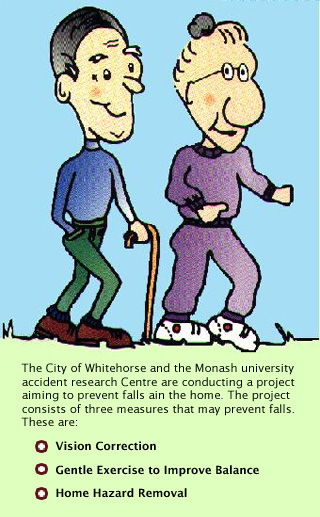Preventing falls – Background
Falls in the Elderly
 In many countries, including Australia, injuries due to falls are one of the most common reasons for hospital admission in the elderly. Elderly people are at a higher risk of falling than younger adults. Elderly people often suffer more serious problems as a result of falls than younger adults. These problems include reduced mobility, increased dependence on mobility aids and an inability to live independently at home. Psychological problems can also result including increased anxiety, loss of confidence and withdrawal from social activities.
In many countries, including Australia, injuries due to falls are one of the most common reasons for hospital admission in the elderly. Elderly people are at a higher risk of falling than younger adults. Elderly people often suffer more serious problems as a result of falls than younger adults. These problems include reduced mobility, increased dependence on mobility aids and an inability to live independently at home. Psychological problems can also result including increased anxiety, loss of confidence and withdrawal from social activities.
Elderly people are susceptible to falls for a variety of reasons. Factors relating to aging include the increased incidence of medical problems such as stroke and arthritis, deteriorating balance, difficulty walking, and the increased use of medicines including sedatives. Environmental factors include stairs that are difficult to negotiate or in poor condition, poor lighting, slippery floors, slippery mats and rugs, and slippery surfaces in bathrooms.
The consequences of falls are often worse for the elderly due to their more brittle bones. The injury sustained from a fall is related to the extent of brittleness in an individual’s bones.
Several types of interventions aimed at reducing the risk of injury in the elderly have been tried in Australia and overseas. These include education programs, home modifications, behaviour change and exercise. Some of these interventions were evaluated. However there were problems with the evaluations including small sample sizes, lack of a control group, failure to control for baseline differences between control and intervention groups, and reliance on participants’ recall of falls over a long period of time.
Objectives
The primary objective was to investigate the effectiveness of three interventions – exercise, vision correction and home hazard removal – for reducing fall risk in elderly people living at home. The study design allowed examination of the effects of the interventions alone and in combination.
A second objective was to explore the effects of the interventions on other factors related to falling. These included psychological factors like fear of falling, and health related factors such as use of medical services.
Interventions
The exercise intervention involved attending 15 weekly strength and balance exercise sessions led by trained instructors. Participants were asked to do 30 minutes of the exercises at home every day.
Participants receiving the vision correction intervention were referred to eye specialists for problems identified in the baseline risk assessment.
The home hazards removal intervention involved removal of home hazards identified in the baseline risk assessment subject to the agreement of the participant and provided that the work required was not costly.
Summary of stages in the study
- Recruitment letter sent to all residents aged 70+ in City of Whitehorse
- Telephone follow up of those not responding to recruitment letter
- Telephone screening for initial inclusion and exclusion criteria
- Home-based baseline assessment of background and risk factors
- Random assignment to intervention group
- Appropriate intervention(s) implemented
- Ongoing recording of falls by participants
- Falls calendars mailed in each month
- Follow up of participants failing to return calendar
- Random selection of participants for follow up assessment
- Home-based follow up assessment of risk factors
Funding
The project was funded by the National Health & Medical Research Council, the Victorian Department of Human Services (Aged Care), the City of Whitehorse, the Victorian Health Promotion Foundation, and the National Safety Council.
The future
Click the play button to hear Lesley Day’s response. |
“What further work have you done as a result of being involved in the No Falls project?”